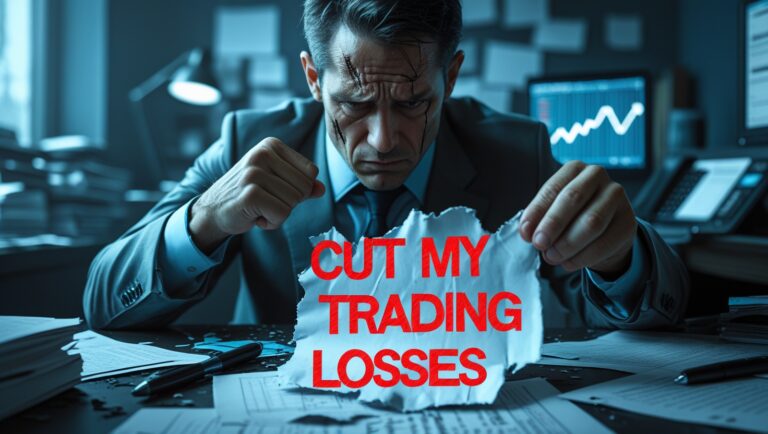How I Learned to Trust My Trading Plan and Stop Second-Guessing
How I Learned to Trust My Trading Plan and Stop Second-Guessing
I used to second-guess almost every trade. I’d create a plan the night before, mark my levels, visualize my setup — and then throw it all out the window the second the market opened. Sound familiar?
It took me a long time to understand that my problem wasn’t my strategy — it was trust. I didn’t trust myself. I didn’t trust my analysis. And because of that, I was constantly reacting to the market instead of following my plan.
That hesitation? It cost me trades, confidence, and a lot of money.

Table of Contents
My Plan Wasn’t the Problem — My Mindset Was
There were days I’d chart out the perfect setup, even journal why I was confident in it — then I’d watch it play out without me because I hesitated. Other times, I’d enter too early, exit too fast, or second-guess the entry altogether.
It wasn’t until I looked back at my journal that I realized something: most of my losses weren’t from bad trades — they were from broken trust. I wasn’t sticking to my plan long enough to see it work.
Trust Comes From Repetition and Results
The only way I started trusting my trading plan was by giving it a real chance. I committed to following the same process for a few weeks — no matter what. Win or lose, I stuck to the plan and tracked the outcome.
What I saw shocked me. The trades that followed my setup — with no hesitation or early exits — performed the best. The ones I interfered with? That’s where the losses piled up. The data gave me confidence to finally stop overthinking.
I Stopped “Fixing” a Plan That Wasn’t Broken
One mistake I used to make was constantly tweaking my strategy after one loss. I’d change indicators, adjust risk, or look for a new setup. But after journaling and reviewing, I saw the problem wasn’t the strategy — it was me not following it consistently.
So I made a decision: If I’m going to build a plan, I’m going to trust it. And if I don’t trust it, I won’t trade it. That mindset simplified everything.
Emotions Will Always Be Loud — But I Learned to Stay Quiet
Now when I enter a trade, I remind myself: I already did the thinking. The analysis was done hours ago. My only job now is to execute without emotion. The more I practice that, the easier it becomes.
If I start to feel unsure mid-trade, I go back to my rules: Did I follow my entry? Is my stop in place? Is this within my setup? If the answer is yes, I do nothing. That one habit alone has helped me become a more stable trader.
Want to See the Plan I Actually Trust?
Everything I use now — from building my watchlist to managing risk — is inside this ebook:
👉 Pay Your Bills with Stocks
It’s a no-fluff breakdown of how I find clean setups, avoid overtrading, and stick to a routine that works — not just once, but consistently. If you’ve been jumping from strategy to strategy, this will help you finally anchor down.
Final Thoughts
Trust isn’t built in one day — and it’s not built by luck. It’s built by following your plan repeatedly, through the ups and downs, and letting the results speak for themselves.
The moment I stopped second-guessing and started following through, my entire trading game changed. I don’t win every trade, but I trust every decision — and that’s what gives me peace, consistency, and growth.
If you’re still doubting your plan, give it the commitment it deserves. You might be closer than you think.
One thing I had to learn the hard way was this: second-guessing usually starts before the trade even happens. I’d hesitate at the open, stare at my levels, then question everything I wrote down the night before. That habit created a cycle of fear, doubt, and missed opportunities.
The more I hesitated, the more I felt like I needed a new system. But it wasn’t my setup that needed fixing — it was my commitment to execution. You can’t test a strategy you never fully follow. That hit me one day and changed how I approached every trade after.
So I challenged myself. I gave my plan a full 30-day test. No second-guessing, no altering mid-trade. Just pure follow-through. And guess what? My results were more consistent in those 30 days than they had been in months. That’s when I realized how powerful routine and discipline really are.
I also started writing down exactly why I trusted each setup before the trade. Just a quick note like “clean bounce off support + strong volume + clear risk.” That little reminder gave me the confidence to sit through the noise and avoid panic exits.
Another trick I use: I ask myself, Would I still take this trade if I couldn’t watch it after entering? If the answer is no, I skip it. If I wouldn’t trust it enough to leave it alone, then I’m not really respecting the plan.
Over time, I learned to separate feelings from facts. Just because a candle pulls back doesn’t mean the setup failed. Just because I feel nervous doesn’t mean the trade is bad. My job isn’t to feel good in every trade — it’s to stick to my system and let the numbers play out.
The more trades I took strictly based on my plan, the more confident I became. Confidence doesn’t come from guessing right — it comes from knowing your process inside and out. That’s what helped me stop comparing myself to other traders too.
A lot of traders jump ship too early — they want a strategy that wins every time. But there’s no such thing. You need to trust your edge through the drawdowns, or you’ll be chasing new strategies forever. I had to sit through losing streaks to understand that trust means sticking it out, not switching paths.
Once I built that trust, I stopped overanalyzing. I didn’t need a dozen indicators or other people’s opinions. If my plan said yes, I was in. If not, I waited. That kind of clarity changed how I trade — and how I feel about trading.
And here’s something I didn’t expect: the more I trusted my plan, the less I felt emotionally attached to the results. A red trade didn’t rattle me. A green trade didn’t make me cocky. I was finally thinking like a professional, not just a person clicking buttons.
If you’re still stuck in that cycle of doubt, I walk through everything I use — my criteria, setups, risk rules, and daily checklist — inside this:
👉 Pay Your Bills with Stocks
It’s not just about picking good trades. It’s about sticking to them with discipline and finally getting the results that come with consistency.
Every trader wants results, but few are willing to build trust in their process. Once you do, though, the game changes. You don’t need to be perfect — you just need to show up for your plan every day and let it work for you.

Stay ahead in the stock market! Subscribe to our newsletter and receive exclusive stock flow reports, trading insights, and actionable tips directly in your inbox. Join thousands of traders who get our updates first.







